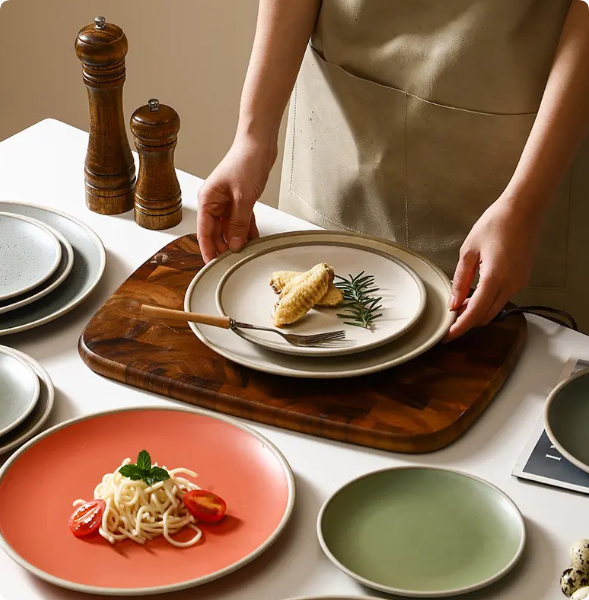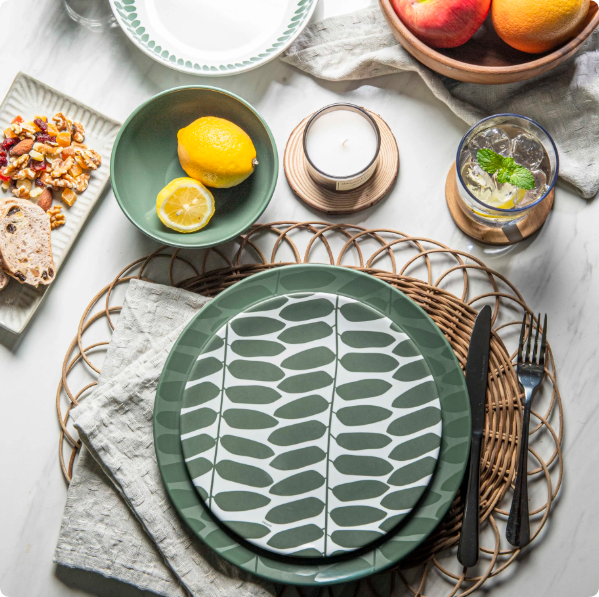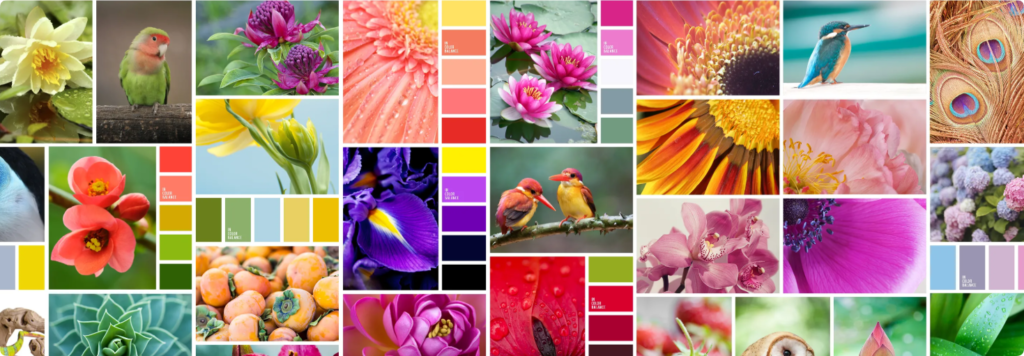When we think about ceramic dinnerware, the first images that often come to mind are gleaming plates, bowls, and mugs—each reflecting artistry and utility. The appeal of ceramic dinnerware lies not just in its durability or craftsmanship, but also in the artistry of its design. A significant influence on the aesthetics of ceramics comes from the natural world—plants, minerals, geological formations, and even weather patterns. The colors and shapes of ceramic dinnerware are deeply intertwined with nature, providing a timeless connection between the items we use in our everyday lives and the environment around us.
In this article, we will explore the different ways nature influences the design and colors of ceramic dinnerware, focusing on the interplay between natural materials, environmental elements, and cultural significance. We will examine these influences through detailed comparisons, providing you with insights into how nature shapes the products that grace dining tables worldwide.
How Nature Shapes Ceramic Dinnerware Colors
Color is one of the most striking elements of ceramic dinnerware. Whether it’s the earthy tones of terracotta, the cool blues of ocean-inspired designs, or the vibrant greens of nature’s flora, these colors often reflect the world around us. The pigments used in ceramic dinnerware come from natural sources, and the choice of colors can often evoke the beauty of nature itself.
1. Earthy Tones and Terracotta

Terracotta is perhaps one of the most iconic natural colors in ceramic dinnerware. Derived from the earth, this reddish-brown color is a result of the natural clay used in the pottery process. Terracotta, with its warm, rustic hue, evokes a sense of organic simplicity. These earthy tones are deeply associated with ancient pottery, and they continue to be a favorite for handmade dinnerware today.
Natural terracotta dinnerware often showcases slight variations in color, as no two pieces are exactly alike. This randomness, which results from the clay’s minerals and the firing process, mirrors the uniqueness of natural materials. The warm tones of terracotta also evoke feelings of comfort and connection to the earth.
2. Ocean Blues and Cool Tones

The color blue is often associated with tranquility, calmness, and the vastness of the sky and ocean. In ceramics, various shades of blue are derived from natural minerals like cobalt and copper. These minerals, when incorporated into glazes, create rich blues that resemble the colors of the sea or sky.
Ocean-inspired ceramics are particularly popular for creating a relaxing dining environment. Soft blues and greens in dinnerware can bring to mind peaceful seaside retreats, and they often create a refreshing contrast to the warmer tones of wood and stone in a dining room.
3. Forest Greens and Nature-Inspired Hues

Green is the color of nature—of plants, trees, and life itself. When translated into ceramic dinnerware, green tones can take on a variety of shades, from deep forest greens to lighter, pastel greens. These colors are often obtained through natural pigments like iron oxide, which gives the ceramics a grounded, earthy feel.
Forest green ceramics, for example, can invoke the feeling of being surrounded by a lush forest, while lighter greens might bring to mind fresh spring growth. These natural greens are calming and refreshing, often used in dinnerware designed for outdoor dining or nature-inspired themes.
How Nature Influences Ceramic Shapes
While color is often the first thing we notice in ceramic dinnerware, shape plays an equally important role in evoking the natural world. The shape of dinnerware often reflects the forms found in nature—smooth curves, flowing lines, and organic contours. From the roundness of pebbles on a beach to the spirals found in seashells, natural shapes have a profound influence on ceramic design.

1. Organic, Flowing Shapes
One of the most significant ways nature influences ceramic shapes is through organic, flowing designs. Much like the shapes of leaves, flowers, and other natural elements, ceramic shapes are often created to mimic the curves and lines found in nature. These organic shapes bring a sense of fluidity and natural movement to dinnerware, making the pieces feel more alive and connected to the environment.
Plates and bowls with soft, rounded edges often reflect the shapes of natural objects. For example, shallow bowls with slightly raised, curving sides may evoke the image of a lotus flower or a petal’s soft curve. These shapes bring a sense of peace and tranquility to the dining experience, making them particularly suitable for family gatherings or casual, relaxed meals.
2. Geometric Natural Forms
While organic curves dominate much of the ceramic dinnerware world, geometric shapes also have their place in nature-inspired design. The hexagonal pattern of honeycomb cells, the symmetry of flowers, and the angularity of mountain peaks are all examples of natural geometry. These shapes bring a sense of order and balance to dinnerware.
In modern ceramic design, some manufacturers use geometric forms, such as square or rectangular plates, inspired by the clean, sharp lines found in nature. These pieces often feature minimalistic designs, with simple patterns and polished finishes that highlight the beauty of geometric simplicity.
3. The Influence of Pottery Traditions and Cultural Symbolism
In addition to mimicking natural forms, the design of ceramic dinnerware is also influenced by cultural interpretations of nature. In various cultures, certain shapes and symbols have deep meanings. For example, in Asian pottery, the round shape symbolizes harmony and completeness. The use of nature-inspired shapes, such as flowers or animals, is often embedded with cultural significance, which is reflected in the ceramic dinnerware’s design.
Comparing Different Nature-Inspired Ceramic Collections
To better understand the differences in how nature influences ceramic dinnerware colors and shapes, we can compare a few popular ceramic collections inspired by nature. Below is a comparative table highlighting the color palette, shape influences, and cultural significance of different nature-themed ceramic collections.
| Collection Name | Color Palette | Shape Influence | Cultural Significance |
|---|---|---|---|
| Terracotta Tradition | Earthy reds, browns, and oranges | Organic, rounded shapes, often rough textures | Symbolizes groundedness, simplicity, and connection to the earth |
| Ocean Breeze Collection | Soft blues, turquoise, and whites | Flowing, circular, or wave-inspired shapes | Represents tranquility, calmness, and nature’s serenity |
| Forest Green Series | Deep greens, olive, and mossy tones | Leaf-like curves, soft edges, and round forms | Symbolizes renewal, nature, and growth |
| Geometric Nature Designs | Neutral earth tones, light grays, and whites | Angular, geometric patterns inspired by natural symmetry | Emphasizes balance, symmetry, and harmony in nature |
Conclusion: Why EKA Ceramic Dinnerware Stands Out
At EKA, we understand the powerful connection between nature and the design of ceramic dinnerware. Drawing inspiration from the elements of nature, our collection blends organic forms with modern aesthetics, offering high-quality ceramic dinnerware that reflects the beauty of the natural world.
Our products cater to a wide range of customers, from home and kitchenware buyers to gift merchants and cross-border e-commerce sellers. We offer both OEM and ODM services, allowing clients to personalize designs that reflect their own cultural interpretations of nature. Whether you’re looking for earthy terracotta tones, oceanic blues, or forest greens, EKA’s ceramic collections are crafted to bring the beauty of nature to your dining table.
By embracing nature-inspired colors and shapes, EKA ceramics not only add elegance and function to your kitchenware collection but also provide a meaningful connection to the world around us. Our commitment to quality and craftsmanship ensures that each piece of dinnerware brings nature’s beauty into every meal.

